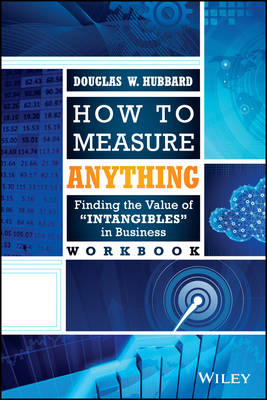
How to Measure Anything Workbook
John Wiley & Sons Inc (Verlag)
978-1-118-75236-4 (ISBN)
The invaluable companion to the new edition of the bestselling How to Measure Anything This companion workbook to the new edition of the insightful and eloquent How to Measure Anything walks readers through sample problems and exercises in which they can master and apply the methods discussed in the book.
The book explains practical methods for measuring a variety of intangibles, including approaches to measuring customer satisfaction, organizational flexibility, technology risk, technology ROI, and other problems in business, government, and not-for-profits.
Companion to the revision of the bestselling How to Measure Anything
Provides chapter-by-chapter exercises
Written by industry leader Douglas Hubbard
Written by recognized expert Douglas Hubbard—creator of Applied Information Economics—How to Measure Anything Workbook illustrates how the author has used his approach across various industries and how any problem, no matter how difficult, ill defined, or uncertain can lend itself to measurement using proven methods.
DOUGLAS W. HUBBARD is the inventor of Applied Information Economics (AIE). He is an internationally recognized expert in the field of decision analysis and challenging measurements and is a popular speaker at numerous conferences. AIE method has been applied to dozens of large Fortune 500 IT investments, military logistics, venture capital, aerospace, and environmental issues. Doug is the author of How to Measure Anything: Finding the Value of “Intangibles” in Business (Wiley).
Preface ix
About the Author xi
Part I Questions 1
Chapter 1 The Challenge of Intangibles 3
Learning Objectives 3
Chapter Overview 3
Questions 4
Chapter 2 An Intuitive Measurement Habit: Eratosthenes, Enrico, and Emily 9
Learning Objectives 9
Chapter Overview 9
Questions 10
Chapter 3 The Illusion of Intangibles: Why Immeasurables Aren’t 15
Learning Objectives 15
Chapter Overview 15
Questions 16
Chapter 4 Clarifying the Measurement Problem 23
Learning Objectives 23
Chapter Overview 23
Questions 24
Chapter 5 Calibrated Estimates: How Much Do You Know Now? 31
Learning Objectives 31
Chapter Overview 31
Questions 32
Chapter 6 Quantifying Risk through Modeling 39
Learning Objectives 39
Chapter Overview 39
Questions 40
Chapter 7 Quantifying the Value of Information 47
Learning Objectives 47
Chapter Overview 47
Questions 48
Chapter 8 The Transition: From What to Measure to How to Measure 55
Learning Objectives 55
Chapter Overview 55
Questions 56
Chapter 9 Sampling Reality: How Observing Some Things Tells Us about All Things 61
Learning Objectives 61
Chapter Overview 61
Questions 62
Chapter 10 Bayes: Adding to What You Know Now 69
Learning Objectives 69
Chapter Overview 69
Questions 70
Chapter 11 Preference and Attitudes: The Softer Side of Measurement 77
Learning Objectives 77
Chapter Overview 77
Questions 78
Chapter 12 The Ultimate Measurement Instrument: Human Judges 87
Learning Objectives 87
Chapter Overview 87
Questions 88
Chapter 13 New Measurement Instruments for Management 93
Learning Objectives 93
Chapter Overview 93
Questions 94
Chapter 14 A Universal Measurement Method: Applied Information Economics 99
Learning Objectives 99
Chapter Overview 99
Questions 100
Part II Answers 105
Chapter 1 The Challenge of Intangibles 107
Chapter 2 An Intuitive Measurement Habit: Eratosthenes, Enrico, and Emily 109
Chapter 3 The Illusion of Intangibles: Why Immeasurables Aren’t 111
Chapter 4 Clarifying the Measurement Problem 115
Chapter 5 Calibrated Estimates: How Much Do You Know Now? 117
Chapter 6 Quantifying Risk through Modeling 119
Chapter 7 Quantifying the Value of Information 125
Chapter 8 The Transition: From What to Measure to How to Measure 129
Chapter 9 Sampling Reality: How Observing Some Things Tells Us about All Things 131
Chapter 10 Bayes: Adding to What You Know Now 135
Chapter 11 Preference and Attitudes: The Softer Side of Measurement 137
Chapter 12 The Ultimate Measurement Instrument: Human Judges 139
Chapter 13 New Measurement Instruments for Management 141
Chapter 14 A Universal Measurement Method: Applied Information Economics 143
| Erscheint lt. Verlag | 15.4.2014 |
|---|---|
| Verlagsort | New York |
| Sprache | englisch |
| Maße | 152 x 226 mm |
| Gewicht | 204 g |
| Themenwelt | Wirtschaft ► Betriebswirtschaft / Management ► Unternehmensführung / Management |
| ISBN-10 | 1-118-75236-8 / 1118752368 |
| ISBN-13 | 978-1-118-75236-4 / 9781118752364 |
| Zustand | Neuware |
| Haben Sie eine Frage zum Produkt? |
aus dem Bereich


